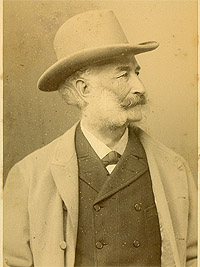Adolph Sutro (1830–1898)

Adolph Sutro was the classic California dreamer and self-made man. He came to California with nothing and took advantage of the openness and vast opportunity of the Gold Rush to turn his vision into reality. He was also the classic American tinkerer, independent cuss, and free spirit (and friend of Mark Twain), who became obsessed with his ambition—to build a tunnel through the Comstock Lode silver mines. In the process, he took on, and triumphed over, the Bank of California, the most powerful institution in the West.
Born in 1830 in Aachen, which was at the time in the state of Prussia, Sutro came to California at age 20 via a harrowing passage through Panama in 1850. He was hired by August Helbing to become Helbing’s “fire watcher.” (Helbing was the founder of the oldest continuous nonprofit in the West, the Eureka Benevolent Society, now San Francisco Jewish Family and Children's Services.) Sutro slept under the counter of Helbing’s store in exchange for keeping an eye on the business at night and protecting it against vandals and arson. One night, encountering a robber on the street, he was slashed in the cheek. To cover the scar, he grew muttonchops, which he sported for the rest of his life.
Sutro suffered a number of business reversals during the 1850s, until he finally established himself as a tobacconist. In 1860, when gold and silver were discovered in Virginia City, Nevada, he sold his three tobacco stores and went there alone, while his wife stayed in San Francisco with their three children. He opened a refining mill to extract silver quartz, which yielded a modest profit. But for years he had been incubating a grand idea, and he finally began to execute it: a four-mile tunnel, 1,500 feet below ground, through the Comstock Lode to drain the water from the mines, allowing the silver to be extracted. He spent 15 years working on the project—lobbying Congress, convincing the miners and the State of Nevada to back him, gaining financing from European sources, and fighting William Ralston and the Bank of California, which wanted to get in on the riches and every step of the way tried to derail Sutro. The tunnel was finished in 1878. In 1880 he sold his shares in it and became a multimillionaire. Shortly thereafter, the mines dried up and the tunnel was useless.
All along, Sutro had his eye on San Francisco. He revered the city and saw it as the incubator of the future, not just for Californians, but for the human race. He wrote:
I have the most exalted ideas regarding the future of California. I think we will grow in population, we will grow in commerce, we will grow in civilization and arts and sciences until we will rank first among our countries, and my reason for it is, that the invigorating climate of California is such, that under development, the human physique will grow and the mind will grow in the same proportion as the physique develops, and produce a magnificent man and woman of bright mind and liberal in their views and go-ahead spirit, who would foster and encourage the development of all the better traits of nature. I think California will be thickly populated, and the Pacific Coast, from San Diego to the Straights of Fuca, and between the Pacific Ocean and the Sierra Nevada Mountains will, in course of time, be capable of supporting a population of 30,000,000 people and support them well….
Sutro had bought a great deal of San Francisco real estate during the depression of the mid- and late 1870s. He acquired both prime downtown commercial real estate and vast stretches of what was known as the “outside lands,” which covered the barren southern and western sections of the city all the way to the ocean. As the city’s largest landowner, he held at one point one-twelfth of San Francisco. He built himself a modest home on San Francisco’s northwest shoreline in the 1880s. The surrounding gardens were lavish and open to the public free of charge. He also constructed the elaborate Sutro Baths. The largest indoor swimming facility in the world, it could accommodate 10,000 swimmers. Sutro was also an early environmentalist. He protected the seals off nearby Point Lobos and successfully lobbied Congress to pass a law putting the area in trust for the American people.
Although he was one of the city’s largest landowners, he was revered by the working class as its champion, in large part because he took on and defeated William Ralston’s predatory Bank Ring. Sutro, a progressive, represented the Populist Party. Despite his wealth, he was considered a man of the people and became the choice to lead a radical third party that would challenge the Southern Pacific Railroad and its political cronies. Richard White wrote in Railroaded, his Pulitzer Prize–nominated book on the railroads and the building of the West: “In 1896 when Sutro was running for mayor, Colis P. Huntington had his nephew Henry put a detective on Sutro, to uncover enough dirt to discredit him. But he wasted his money. Huntington called him a ‘pestiferous cuss’ and ‘as incorruptible a man, I think, as there is on the West Coast.’”
Sutro said in his oral history:
I don’t believe in aristocracy. . . . The aristocracy of the mind is the only aristocracy I recognize. It makes no difference to me whether a man has not got a cent or whether he is a millionaire. On the contrary, when a man is wealthy, I am more suspicious of him than I am of a poor man. I have found it in my experience that rich men, as a general thing, lose a great deal of the better feeling which they had when they were poor.
What drove Adolph Sutro? Like many successful businessmen of his day, he could have retired comfortably in his aerie above the Pacific Ocean, hosting lavish dinners and enjoying the view from his vast estate, which stretched from the Pacific Ocean to the center of the city. That may have been his instinct. He said:
I am not of a social disposition. I am very much alone. I spend more hours alone than any man you ever saw. I am not particularly lonely. When I am alone, I think about one subject and another that interests me. My recreation is largely in thinking.
But he was also restless and in need of a platform and a cause. In 1894 he decided to run for mayor of San Francisco. In his campaign he railed against big business and backed the unions in the violent Pullman strike that was tearing up cities and towns across the country. He got most of the working-class vote and in a field of six received an absolute majority.
His two-year term—as the first Jewish mayor of a major American city—was ambitious but not successful. He supported women’s suffrage and opposed the Southern Pacific. However, the city charter gave the mayor little power, and the Board of Supervisors did not have another Populist, so he was blocked every step of the way. Sutro said:
What have I accomplished as Mayor? Very little. The Mayor is little more than a figurehead…I have always been master of a situation; I have always had a number of men under my employ, and they did as I told them. I could not manage the politicians.
After he left office, he returned to his quest to improve San Francisco for the average citizen. He planted trees throughout the city (40,000 over 1,000 acres) and donated 26 acres on Mount Parnassus to the University of California for its medical school (today’s UCSF). Some of the collection was destroyed in the 1906 earthquake and fire. His family gifted his personal library—one of the largest private collections in the United States—to the California State Library. The remainder is now housed at The California State Library's Sutro Branch, located on the campus of San Francisco State University.
As Mark Twain wrote years after Sutro’s death in 1898: “Twenty years ago I knew Adolph Sutro well...a fine, manly beautiful character. And I have always found something of Sutro in all the Jews whom I have personally known since. A part of Sutro is sufficient equipment for an average man.”


